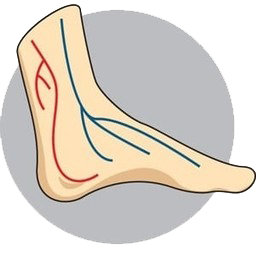
Insulin is a hormone that helps the body deal with sugar (glucose) in the diet. When diabetes is present, either the body produces less or no insulin (Type 1) or the body tissues are resistant to the effects of diabetes (Type 2). This results in higher levels of glucose in the blood, which can damage a whole range of body tissues and organs.
The foot is especially affected by diabetes because:
- diabetes damages the nerves (damage can occur to the foot and not be detected) – this is called peripheral neuropathy.
- diabetes also affects the circulation. Poor circulation can affect the ability of the body to heal when damage occurs.
- those with diabetes are more prone to infection – the body’s processes that normally fight infection respond slower and often have trouble getting to infections due to the poor circulation.
- diabetes can also affect the joints, making them stiffer
- other diabetes complications that can also affect the foot, for example, kidney disease (affects proteins that are involved in wound healing) and eye disease (can’t see the foot to check for damage).
As a consequence of these factors, a number of things can go wrong:
- the foot may get damaged and you do not know about it (for example, your shoe rubs a sore onto a toe that gets infected – you can not feel it because of the peripheral neuropathy – you can not heal very well due to the infection and poor circulation).
- foot ulcers are common infections can spread
- the ultimate worst case scenario of this process is an amputation.
Diabetes is the main cause of foot amputations.
Charcot’s joints are another complication of diabetes in the foot, especially if peripheral neuropathy is present – the neuropathy causes numbness (imagine spraining your ankle and not knowing you have done this. You will continue to walk on it – imagine the damage that this would do. This is what happens in a Charcot’s foot).
Management
If you have diabetes and diapetic foot there are a lot of things you need to do to prevent the problems from developing in your feet:
- Checking blood sugar levels
- Wash your feet daily (use a mild soap and lukewarm water).
- Inspect your foot daily (check sores, cuts, bruises, and changes to the toenails; use a mirror to look under the foot if you can not see it).
- Look after your health
- Look after your feet (e.g. cut toenails often, do not try to remove corns and calluses yourself, avoid going barefoot
- The fitting of footwear is very important. Poorly fitted shoes are a common cause of problems in the feet of those with diabetes. New shoes should be comfortable when purchased and should not need a “break-in” period. They should fit both the length and width of the foot, with plenty of room for the toes. Avoid shoes with high heels, pointed toes, or tight around the toes (these put too much pressure on parts of the foot and can contribute to ulcers).
- Wear an orthotic that offloads pressure on your feet.
- See a Podiatrist, at least annually.
Podiatrists have an extremely important role to play in the prevention and management of complications of the foot in those with diabetes. All those who are at risk for a problem should have that risk status assessed at least annually (more if the risk is greater). The podiatrist should communicate this risk status to other members of the healthcare team. Advice should be given on how to reduce the chance of damage happening, what to do to prevent it, and what to do if something does go wrong.
Regular foot care from a podiatrist is a key way to prevent problems from developing in those who are at risk. When something does go wrong, see a Podiatrist immediately. Waiting a “few days to see what happens” before seeing someone may be the difference between a good and poor outcome. The sooner treatment is started, the better.










